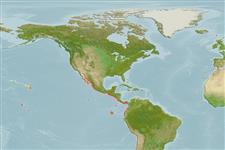Teleostei (teleosts) >
Anguilliformes (Eels and morays) >
Ophichthidae (Snake eels) > Ophichthinae
Etymology: Apterichtus: From the Greek απτερόν (apteron), without fins, and ίχθύς (ichtus, more correctly written ichthys; masculine), fish.
More on authors: Myers & Wade.
Environment: milieu / climate zone / depth range / distribution range
Ecology
Marine; demersal; depth range 10 - 134 m (Ref. 101270). Tropical; 29°N - 1°S
Eastern Pacific: between the Gulf of California and the Galapagos Islands.
Size / Weight / Age
Maturity: Lm ? range ? - ? cm
Max length : 31.2 cm TL male/unsexed; (Ref. 101270)
Short description
Identification keys | Morphology | Morphometrics
This species is distinguished by the following characters: tail 1.8-2.0, head 11-16, and body depth 43-50 in total length; preopercular pores 3 and pores in supratemporal canal 3; teeth conical and uniserial on jaws and vomer; vomerine teeth 4-5; body coloration when preserved is uniform light tan, overlain with fine sparse brown speckling, branchial region and top of head with irregular small dark spots and blotches; MVF 59138, 132-146 total vertebrae (Ref. 101270).
Inhabits sandy and muddy bottoms, from shallow waters (Ref. 9328); captured by rotenone, dredge and trawl (Ref. 101270).
Life cycle and mating behavior
Maturity | Reproduction | Spawning | Eggs | Fecundity | Larvae
McCosker, J.E. and Y. Hibino, 2015. A review of the finless snake eels of the genus Apterichtus (Anguilliformes: Ophichthidae), with the description of five new species. Zootaxa 3941(1):49-78. (Ref. 101270)
IUCN Red List Status (Ref. 130435: Version 2024-1)
Threat to humans
Harmless
Human uses
Fisheries: bycatch
Tools
Special reports
Download XML
Internet sources
Estimates based on models
Preferred temperature (Ref.
123201): 9.5 - 17.6, mean 12.9 °C (based on 39 cells).
Phylogenetic diversity index (Ref.
82804): PD
50 = 0.5000 [Uniqueness, from 0.5 = low to 2.0 = high].
Bayesian length-weight: a=0.00091 (0.00039 - 0.00215), b=2.99 (2.79 - 3.19), in cm total length, based on LWR estimates for this (Sub)family-body shape (Ref.
93245).
Trophic level (Ref.
69278): 3.8 ±0.6 se; based on size and trophs of closest relatives
Resilience (Ref.
120179): High, minimum population doubling time less than 15 months (Preliminary K or Fecundity.).
Fishing Vulnerability (Ref.
59153): Low vulnerability (21 of 100).
